Education Reform
Seen Through The Eyes of a Mime-Dancer
By KAREN MONTANARO
March, 2013
(Continued)
For me, this was living proof that there is a standard that surpasses understanding . . . a standard where objectivity and subjectivity come together to unite people rather than divide them . . . a standard that hits people of different backgrounds and cultures right where we all live. The individual’s experience IS the art standard!
According to the art standard, a kid can say, “This is a great poem,” and be right. Or, “That’s a stupid song,” and be right. The teacher suspends all judgement in the process of zeroing-in on the kid’s internal sense of “right” and exposing him/her to higher expressions of that same feeling. In this way an arts education may help kids overcome a sense of isolation. It also allows them to raise their own standards through a wide range of artistic expressions.
RUMI’S FIELD
“Out beyond ideas of wrong-doing and right-doing, there is a field. I'll meet you there.” --Rumi
This field is where arts education happens.
The school of right-doing and wrong-doing is important too. It’s critically important to learn that 3 + 3 = 6 and not 7. It’s critically important to hit the right notes during a piano concerto. But it’s equally important to spend time in the educational field beyond right-doing and wrong-doing and to bring the lessons learned there to bear on everything you do.
Many years ago, I learned a valuable lesson in the field beyond wrong-doing and right-doing . . . a lesson that radically changed how I teach ballet.
I was preparing for a performance of Swan Lake and struggling with the White Swan variation . . . particularly the very first step.
My director and coaches tried to help. They talked to me in the language of right-doing and wrong-doing. They reminded me to brush through my first position (before springing up into the rond de jamb develope). They’d say yes, that’s right or no, that’s wrong, or yes, that’s better or no, that’s not as good. They helped me a lot, but the next day, I’d be back to square one, struggling again.
One day, I had a rehearsal with my dance partner, Bill Pizzuto, a former principal with the Boston Ballet. Bill watched me struggle with that first step. He’d stop the music and let me try again. Things went from bad to worse. Eventually, Bill stopped the music and walked over to me. I was tense and frustrated. He put his hand on my arm and met my gaze.
“Karen,” he said softly, “you’ve just made your entrance. You set yourself up center stage and the music pauses. It pauses for only a brief moment, in order to put your audience on the edge of their seats . . . to prepare them for this bugger-of-a-step you’re about to do. And what do you do? You brush through your first position!”
At this, Bill bent over to draw attention to his own feet as he brushed and stopped in 1st position. “THIS,” he said pointing to the exact point of contact between his two heels, “is the miracle! THIS is what you’ve trained all of your life to be able to do and now you’re giving it to your audience. THIS will carry you through the rest of the step.”
As Bill talked, I felt the goose bumps rise on my arms and somehow I knew I’d never have a problem with that step again. In fact, I couldn’t wait for that private/public moment when I brushed through my first position. I always made a point of seeing and feeling my heels come perfectly together, as I said silently to my audience, “THIS is the miracle folks and I’m giving it to you with all the love and sweat that ever poured out of me.”
Bill is a natural arts educator. He approached the lesson of right-doing and wrong-doing through the back door of my own experience. He talked to me in a way that made me “feel physically as if the top of my head were taken off.”
That’s what arts educators do, they teach kids through the kids’ experience. They get them excited about what they’re learning. They maintain high standards and they’ll go the the ends of the earth to inspire kids to meet those standards, not because it’s the right thing to do, but because they’re worth it.
Obviously this approach to teaching doesn’t confine itself to the arts. Even science, technology, engineering and math teachers aim to inspire kids to perform well on their tests. But the arts exist for the sole purpose of enhancing the individual’s experience. And that’s why they can teach us so much about the art of teaching and not merely the way to teach art.
STANDARDS-BASED EDUCATION & ARTS EDUCATION
TWO WINGS OF THE EDUCATIONAL BIRD
I believe that the metaphor of a bird illustrates how a strong educational system operates. The bird represents the individual student and the two wings represent (knowledge gained through) two distinctly different types of education: arts education and standards-based education. Children need a healthy balance of both in order to fly.
In many cases, the skills and values of standards-based education are the same as those taught in the arts. The importance of discipline and focus for example. Both forms of education depend on the proper use of discipline and focus.
But the real usefulness of an arts education depends on how it DIFFERS from standards-based education. Just as the wings of a bird reach in opposite directions, these two types of education reach in opposite directions, to develop different parts of the child and enhance his/her point of view.
For example, standards-based education teaches us that we can always do better. This is true. We can always do better. But without an arts education (as defined in this article), this fact-of-life morphs into the erroneous belief that we're not good enough and we’ll never be "good enough" except when everybody else is "less good" than we are.
Children need both experiences: Standards-based education teaching them they can always do better AND arts education teaching them that they are a standard unto themselves. They are enough.
Although these facts appear to contradict each other, they actually complete each other. Like the wings of a bird, they support each other by reaching in opposite directions and saying two different things.
MORE EXAMPLES
In standards-based education the student is expected to meet the standard
In arts education the student IS the standard.
* * *
Standards-based education teaches us to measure our achievements based on a linear scale (0-100%).
Arts education teaches us to assess our experiences on our own terms.
* * *
Standards-based education teaches students new things -- facts and formulas and procedures that children do not already know.
Arts education concerns itself with what children already know. Kids know what their senses “tell” them. They know what they see, what they hear, and how they feel. Sometimes, what kids "learn" through their senses and their feelings (i.e., due to difficult life-situations, media pressures, video games, etc.) is detrimental to their well-being.
In many ways, I believe an arts education helps kids un-learn some of the unfortunate things they may have learned through their senses and feelings. It does this by heightening their ability to find personal meaning in pictures, personal messages in music, empathy in movement and vitality in sensation. In this way, an arts education helps kids rise above their predilections and access broader and higher realms of possibility.
* * *
On standardized tests, there is one right answer and many wrong answers.
The "tests" that characterize an arts education are moments of truth, where action is called for but there are no preset goals and no right or wrong ways to proceed.
In such moments, the artist experiences a vague sense of possibility, but has no idea what form this will take.
Through such "tests", the art student learns that there are an infinite number of ways to be right and only one way to be wrong. (Paradoxically, the only way to be wrong in the creative process is to let the fear-of-being-wrong take the wind out of your sails.)
Again, students are well served when they learn to move freely and boldly in both situations: i.e., times when there is only one right answer and times when there are an infinite number of right answers. Both situations need to be fully stressed and equally experienced in order to complete one’s education.
* * *
Standards-based education uses clearly defined, physical goals and objectives to promote learning.
Arts education often dispenses with clearly defined, physical goals and objectives in order to promote learning.
* * *
On a standardized test, “to know” is to succeed and to “not know” is to fail.
In arts education, students learn to court the unknown, to go for the half-baked or quarter-baked idea. (They learn that success is often the act of “failing magnificently.”)
* * *
Standards-based education prepares kids for their future by teaching them what they'll need to know.
Arts education prepares kids for their future by enhancing their experience of now.
* * *
Standards-based education supports a competitive culture of one-upmanship that takes on an importance of its own. In this way, standards-based education favors a certain self-centeredness on the part of students striving to excel in this system.
In arts education, selfishness and selflessness are one in the same thing. The highest satisfaction for an artist is to express him/herself in ways that allow other human beings to have their own, personally vital experience.
* * *
Standards-based education teaches us that "good" is a relative value, determined by an outside source (i.e., the teacher or system assessing it).
Arts education teaches us that “good” is an absolute value, determined by the individual experiencing it.
* * *
Standards-based education focuses on the performance.
Arts education, focuses on the performer.
“I’m not interested in how my dancers move. I’m interested in what moves my dancers.”
--Pina Bausch, director of Tanztheater Wuppertal
“'What you’re doing' is not as important as WHAT 'what you’re doing' does to you.”
--Tony Montanaro, world renowned mime artist
* * *
In standards-based education to be "the best" is to be better than everyone else.
In arts education, to be "the best" is to be yourself . . . and to begin the life-long process of discovering what this really means.
These are only a few examples of how an arts education complements a standards-based education. In the same way that two wings of a bird reach in opposite directions to lift and stabilize the bird, these two forms of education lift and stabilize children, as they learn painstakingly how to direct their own flight pattern.
(Return to Page 1)
Return to School Programs.

CLICK HERE
Karen's Public Speaking Program
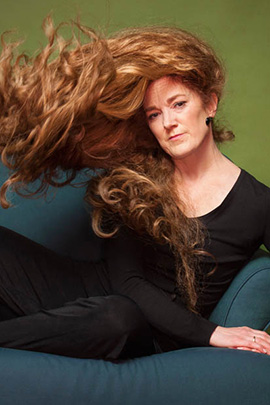
New Promo Pics Click Here!
Photocredit: George C. Anderson
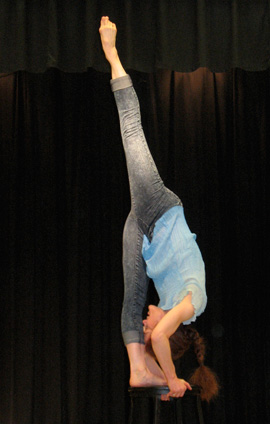
A Visit to Sanford (News Article)
Photocredit: Argy Nestor
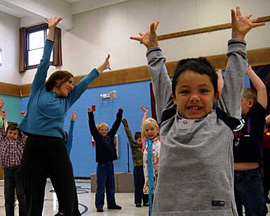
Bringing Magic (News Article)
Photocredit: Times Record
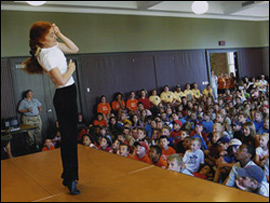
School Assemblies Click Here!
Photocredit: The Sun Journal

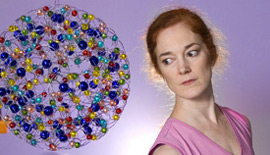
A Dance To Touch The Soul
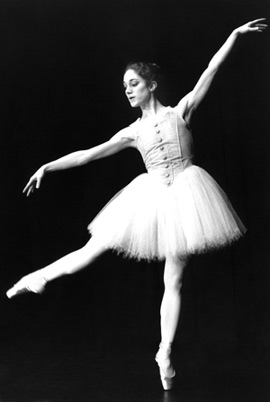
Concerts CLICK HERE!
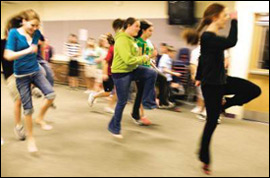
Workshops CLICK HERE!
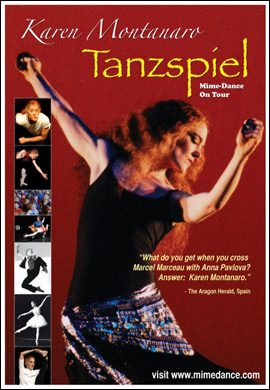
Presenter Resources CLICK HERE!
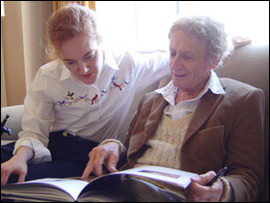
Karen with Marcel Marceau
Read More in "Backstage"